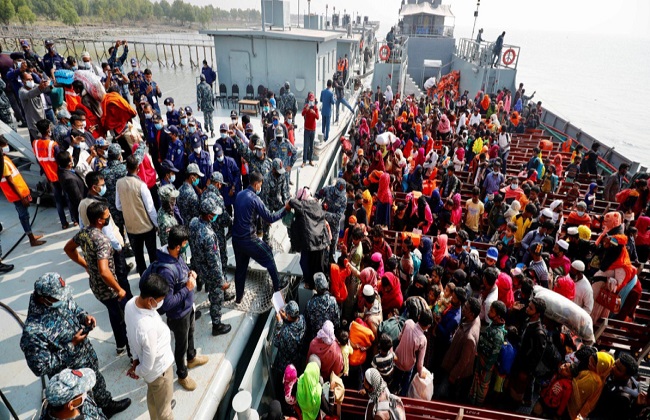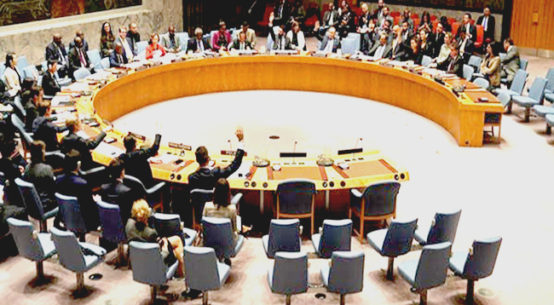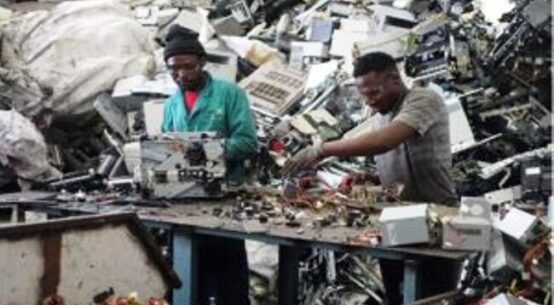
On a dry and hot summer afternoon last year, Achala Navaratne, then the country representative at American Red Cross in Bangladesh, was busy supporting the Bangladesh Red Crescent Society with a cyclone preparedness program in Cox’s Bazar. The southeastern coastal district hosts about a million Rohingya refugees in sprawling camps, which were threatened by the risk of flooding and cyclones as yet another monsoon season approached.
But soon, the preparedness program was overtaken by a more urgent and imminent disaster: His entire team had to help douse a massive fire tearing through the camps.
“We were expecting cyclones to be the largest disaster we might face,” Navaratne, who is now Asia-Pacific acting regional director at ARC, recalled in a recent interview. “Until March 2021, when the fire happened.”
Volunteers in the Rohingya camps and the host communities associated with the local Red Crescent Society chapter immediately moved to minimize the fire’s reach and help the survivors. But it was not enough.
Flames quickly engulfed about 2 square kilometers (about 500 acres) in the midst of the densely packed camps, burning down more than 17,000 shanties and makeshift huts built with bamboo and plastic roof tarps. The blaze faded the next day, and the ruins left a gray imprint on the ground, but not before it killed at least 15 people, leaving over 400 missing.
If the humanitarian response to the fire was a rare display of unity between the locals and refugees, the fire itself was not. It was, in fact, the culmination of numerous accidents and arson attacks targeting the Rohingya camps. By mid-April 2021, a United Nations-backed coordination group recorded 84 fire “incidents” in just four months across the Rohingya camps, and the refugees blamed hostile locals.
This hostility was in stark contrast with how some of the same locals had treated Rohingyas in August 2017, when they arrived in Bangladesh after fleeing attacks by the military junta in Myanmar in what the U.N. rights body described as “a textbook example of ethnic cleansing.”
Five years ago, across the Muslim-majority nation of Bangladesh, there was a massive outpouring of sympathy for the persecuted Rohingyas, who also predominately follow Islam. The fleeing refugees received a particularly warm welcome from the locals in Cox’s Bazar, with whom they share deep and longstanding historical, cultural, and linguistic ties.
Muzammel Huq, a local community leader, was not just offering food and assistance to the Rohingyas; he vacated his private farmlands to shelter some refugees. But five years later, some of the land became part of the vast refugee camp and thus inaccessible; the other portions turned uncultivable because of unfiltered waste and sewage from the camps.
He now feels the guests have overstayed their welcome.
“We gave them shelter because we all are human beings. And we sacrificed so much for that,” Huq told Devex. “But if they do not return soon, the local people in Cox’s Bazar will pay a heavier price.”
Changing attitudes
Few dispute the arrival of nearly 750,000 refugees, who joined about 200,000 others already in Bangladesh, and the resultant aid activities boosted the local economy in Cox’s Bazar, a tourist city with the longest natural sea beach in the world.
In the early years, donor countries poured nearly a billion dollars a year into the response. International aid groups and humanitarian agencies set up near-permanent stations in Cox’s Bazar, resulting in a real estate boom across the city. Even though foreigners hold top-tier positions, local employees dominate mid- and low-end jobs.
But paradoxically, locals also complain about the rising living expenses and informal jobs taken away by cheaper Rohingya labor. There are widespread fears that locals risk being outnumbered by the growing refugee population. The resentment has grown to the extent that the host community even formed committees to “resist” Rohingyas.
Huq, who once provided sanctuary to the refugees, leads one of them.
Part of their bitterness has been funneled toward the aid community too. Since 2019, local groups have protested against NGOs, demanding preferential treatment in their job recruitment, arguing that free rations available to the Rohingyas enabled them to work for lower wages.
But aid groups point out that some of these concerns are not well-founded.
“Ninety-five percent of our staff are Bangladeshi, and all of our procurements are sourced from local suppliers,” Jan Egeland, the secretary general at the Norwegian Refugee Council, said in an emailed response. “On lack of opportunities, we need to focus on the issue at large: the problem is not lack of intention — the problem is lack of funding.”
On a national level, conversations about Rohingyas never fail to note the alleged involvement of refugees with crimes, narcotics trade, and extremism.
And few outsiders experienced the changes in attitudes toward Rohingyas more deeply than ARC’s Navaratne. A Sri Lankan national, he dealt with refugee affairs longer than most, if not all, senior foreign aid officials in Bangladesh after the crisis began in 2017.
“In the beginning, local people were very welcoming and supportive to refugees,” he said. “But challenges emerge when their livelihoods are threatened, or when they see this problem is not going to get resolved soon, or the investments that are made are not very clear to them.”
In his first year in Bangladesh, he helped oversee the humanitarian efforts to combat Cyclone Mora, which saw about 100,000 people evacuated. Two months later, the Rohingyas began fleeing atrocities in Myanmar.
Bangladesh had seen large-scale Rohingya arrivals in the 70s and 90s too, but previous Myanmar governments later allowed them to return. So initially, Navaratne said, the prevalent feeling was, “Okay, this was just a one-off thing; people will go back again.”
But following the latest exodus in August 2017, the civilian government led by Aung San Suu Kyi and then the military regime that overthrew her in February — demonstrated scant interest in taking its nationals back, and soon patience was wearing thin in Bangladesh.
Army and police outposts and watch stations have popped up across the camps, while refugees’ movement is tightly restricted with the installation of barbed wire. Authorities demolish Rohingya-run shops and huts, while aid groups are forced to limit the involvement of Rohingya volunteers.
At the same time, rights groups have alleged that the government stepped up its coercive efforts to relocate some of the Rohingyas to Bhashan Char, the remote island on the Bay of Bengal, decried as unsafe and “prison island.” In August last year, a boat carrying dozens of Rohingyas fleeing from Bhashan Char capsized in nearby water, leaving all the passengers dead or missing.
“It’s no secret that our lives are increasingly difficult,” Abdu Monab, a Rohingya refugee, said. “The only choice available is going to Bhashan Char or going back to Myanmar.”
Some did go back to Myanmar secretly, despite the risks involved.
Bangladesh and Myanmar resumed stalled talks in recent months, with a Myanmar statement suggesting an agreement to repatriate 1,000 refugees on a pilot basis. Bangladesh hopes to start the repatriation by December — an ambitious goal, given other powerful players such as the Rakhine militant group, Arakan Army, and the parallel National Unity Government run by Suu Kyi’s allies have not been consulted. To preemptively counteract Western opposition to a nonvoluntary return, Bangladesh recently helped organize a Rohingya showdown that clamored for repatriation.
Government representatives in Bangladesh did not respond to questions from Devex.
Declining funding
As for the Bhashan Char, things are no less complicated.
In 2019, when the government commenced the Bhashan Char project to house 100,000 refugees, ostensibly to ease pressure in Cox’s Bazar, rights groups fiercely criticized it, arguing that the remote island was prone to cyclones and posed a grave threat to refugees.
The U.N.-led aid community was expressly opposed to operating on the island, citing safety and operational concerns. But as Devex reported then, the UNHCR succumbed once the government moved the first batches of refugees to the island, allegedly through intimidation and coercion.
Some U.N. and aid officials stress they have limited bargaining power with the host government to the frustrations of some donor countries, which fund everything that involves the Rohingyas — including the luxury cars government officials use to travel across camps.
Signed in October 2021, the U.N.-Bangladesh deal on Bhashan Char hasn’t taken off mainly because some major Western donors remain hesitant. Six donor countries fund basic operations on the island mainly through local NGOs, and the World Food Programme has started providing food assistance this month, UNHCR and WFP spokespersons said.
Officials of the U.S. Agency for International Development who visited Bhashan Char in May privately told campaigners that they were “horrified” at the conditions on the island, according to a longtime Rohingya researcher in close consultation with U.S. officials, who sought anonymity because of their ongoing engagement in Bangladesh.
Without meaningful U.N. support, the government has relied on local NGOs and charities to serve Rohingyas stationed on the island. The local chapter of the Red Crescent Society, where the host government traditionally wields more control, is one of them. However, Navaratne insists that the Red Cross and Crescent are “fully aligned with how the humanitarian communities are seeing this.”
Unclear future
Bhashan Char or not, the future of overall support for Rohingyas is also precarious.
The U.N. Refugee Agency has long warned that the pledges of support for Rohingya refugees remain unfulfilled. In 2020, only 65% of the required funding was delivered by donors, down from around 72% to 75% two years earlier. Recognizing the donor fatigue, UNHCR reduced its funding expectation in 2022, but barely half of the funding requested — around $880 million — has been met, the spokesperson said.
“The global squeeze on humanitarian funding, coupled with the war in Ukraine, means the cost of getting aid to the people who need it has risen significantly, while budgets are under ever-increasing pressure,” NRC’s Egeland said. “Meanwhile, the funding available has not changed. In fact, it has suffered a steep decline. The cost of that is reduced programmes for youth, for survivors of abuse, for women and girls, for the elderly and for refugees with disabilities.”
To tackle the shortfall, the World Bank offered long-term assistance but on the condition that refugees should be allowed to integrate into society, causing a furor within the Bangladesh government, which argued such a policy would effectively close the possibility of repatriation. The World Bank maintained the policy was not specific to Bangladesh.
With urgent humanitarian crises emerging, many warn that support for Rohingyas will only wane.
“It’s going to reduce as time goes by because of competing priorities — whether it’s Afghanistan or Ukraine,” Navaratne agreed. “And for a while, unfortunately, these crises might become forgotten crises.”
Nazmul Ahasan is a Bangladeshi journalist pursuing graduate studies in journalism at the University of California, Berkeley. His pieces and reporting contribution have appeared in major publications including The Washington Post, Foreign Policy, The Economist, The Telegraph, and Israeli newspaper Haaretz.


